Fidget Spinners in Space?
In the latest Q&A show from The Naked Scientists, we answer your questions with the help of an expert panel - plant scientist Beverley Glover, mathematician James Grime, physicist Jess Wade and Angel investor Peter Cowley. What makes plants carnivorous, what's the highest prime number we know of, and how do WWII coding machines work? Plus, how long would a fidget spinner spin for in space, what's the best way to water a plant, and what happened to Google Glass?
In this episode

Let's meet the panel
with Beverley Glover, University of Cambridge, Peter Cowley, Angel Investor, James Grime, Numberphile, Jess Wade, Imperial
Chris Smith gets to know our guests ....
We have Beverley Glover. She’s a Plant Scientist at the University of Cambridge. She’s also the Director of the Botanic Gardens in Cambridge. So Beverley, what are you planning for at the moment?
Beverley - Well, lots as always Chris, but I think the big excitement in September is getting ready for our big Apple Day on the 22nd of October. That’s where we try and sort out the best of the science of apples, the horticulture of apples, and what you can cook with apples, and of course, lots of apple tasting with usually 30 or so heritage varieties to try as well. So, it’s a very big deal for us and it takes a lot of getting ready for.
Chris - It’s a big mouthful, but apples are amazing. Is there a lot of science of apples though?
Beverley - There is. It’s surprising actually. Our domestic apple for instance seems to have a very weird hybrid ancestry. Its chloroplast comes from the crab apple but the rest of the genome seems to come from an Asian variety of apple that’s quite different. There's a very interesting hybridization in there way back in time.
Chris - And is it true that apple pips have got cyanide in there that poison you?
Beverley - An awful lot of plants produce cyanide. It’s one of those amazing things that plants have convergently evolved – everything from ferns to the clover in your back garden. A whole range of different plants can make cyanide and yeah, if you get enough of it, it won't do you any good.
Chris - So, avoid apple pips?
Beverley - In quantity.
Chris - I’d have to eat probably 54 apples now wouldn’t I in one sitting, unlikely. Also with us is Peter Cowley. He’s an angel investor. In fact, an award-winning angel investor and invests in new technologies. Just for people not in the know Peter, what is an angel investor?
Peter - Somebody who invest at very, very high risk, very early stage in the business. Then in some cases, helps the business on. So, it’s that initial stage. You probably heard of a programme called Dragon’s Den which actually doesn’t do the angel industry very much good, but that it shows the sort of things that people do.
Chris - Why do you think it gives you a bad rap?
Peter - Because the attitude and the way that the angels or the dragons deal with the people on the program. It’s quite different in the real world. That program was done…
Chris - What you mean, they're nastier in the real world because I heard they're pretty vicious on the telly, aren’t they?
Peter - It can be very nasty.
Chris - Is that reality?
Peter - No, that’s not reality really. I think there's a lot of that lack. Anyway else, a television program is done for the audience, isn’t it?
Chris - Thank you, Peter. So Peter is going to talk to us about tech and he also has a very exciting gadget sitting in front of him, he’s going to introduce to later on. I'm intrigued. Sitting next to Peter is Jess Wade. Now, she’s a Physicist at Imperial College in London. She’s been on the program before. It’s great to have you back, Jess and I understand that earlier this week, you were giving a science talk – no surprises there. You are a physicist but you were doing it with your mum.
Jess - I was indeed. My mother is also a scientist. She’s a psychiatrist and we went to Jodrell Bank which is a really cool place to take your mum especially when she’s from Manchester, to talk about student mental health and how PhD students specifically could access mental health support when they needed it in a time when more and more people need it. More and more people aren’t getting it because the demand is so massive, and it was incredibly difficult being on stage with your mum and not calling her mum the entire time. So, I think I managed all of one time to call her Dr Feinmann. But it was great and she put on this kind of funny strange serious mum voice which was bizarre for me to hear but it was great. And she’s brilliant so it was really fun.
Chris - I persuaded my mum to go on a lecture tour with me once around Australia and we turned up and she looked at the schedule and she said, “You know, I think I’ll just stay in Perth.” So, I went off around the rest of Australia doing this relentless – we still had fun though – and then we reunited at Perth and then we went and saw some wonderful bits of western Australia.
Now sitting next to Jess is James Grime. He’s a maths communicator. He’s also a presenter on Numberphile which is an online video channel about the joy of numbers. It’s also the organization that runs the Enigma project. Now, we would like to put our ‘mathsy’ people on test here, James. But actually, you're going to turn the tables and you have got a challenge for our panel here on the studio, but also everyone at home. What is it?
James - Yes, indeed I do. So, I thought of what would be nice to try is to try some estimation. I want people to consider a teaspoon of sugar. So imagine a teaspoon of sugar. My question is, how many grains of sugar do you think in that teaspoon?
Chris - Peter?
Peter - Yes. Can we ask them not to use Google?
James - Okay, so no Google allowed.
Chris - That’s going to be a hard one to police. So there you are. That’s James’s teaser for this week. Have a think about that. You can ponder on that during the program and we will come back and ask the panel for their thoughts and then James can tell us what he thinks is the actual answer and how he arrived at that answer later on in the program.

05:20 - What makes some plants carnivorous?
What makes some plants carnivorous?
Chris put this question to Beverley Glover from Cambridge Univeristy...
Beverley - Okay, then. What makes some plants carnivorous? It’s a nice question. So, the basic problem of being a plant compared to being an animal is that you can't move. And that defines so many of problems and solutions that plants have come up with. So, it all comes down to nutrients and particularly to nitrogen. So just like an animal, plants need nitrogen to build proteins, all the enzymes in a plant’s body that function to do all the metabolism are built out of amino acids and those amino acids need nitrogen. But nitrogen is really hard to get hold of. We of course, get a hold of it by eating things. So, plants have a whole range of different solutions and most of them are trying desperately to tap as much of it as they can out of the soil where it’s at low concentration and very difficult to mobilise. One or two plants living in generally very particularly nitrogen-poor soils particularly acid soils, some bugs and so on, have hit on the idea of actually just turning the tables and taking it back from the animal’s bodies themselves. So, they tend to have trap mechanisms. They trap insects in place and then once they’re trapped, they use proteases and other enzymes to digest those animal bodies and get the protein back for themselves.
Chris - They're still green though – these plants – aren’t they? So, that means they must have these chloroplasts that enable them to photosynthesise, make chemical energy using the energy in sunlight. So, why do they bother doing that if they can just grab all their food from the air by being a Venus flytrap for example?
Beverley - They wouldn’t get very much food that way actually. It’s a very inefficient way of getting carbon from an animal’s body, much more efficient to do it by photosynthesis. Plants are much better at getting hold of carbon than any animal is. And so, they have the best of both worlds. So getting the carbon from the atmosphere and the nitrogen from the animal’s bodies all at the same time.
Chris - Do you have any success growing these things at the Botanic Garden because I was intrigued by them? And everyone here, I mean, if you all kept these things, Venus flytraps are a sort of staple for children, aren’t they? And they all died. I never managed to keep them alive. I used to feed them diligently. Maybe I overfed them. Maybe it was a case of sort of a Venus flytrap obesity.
Beverley - I think you overfed them, so I can personally tell you that if you feed them tuna, they die pretty quickly.
Chris - Tuna.
Beverley - That doesn’t go down well.
Chris - Why would that happen?
Beverley - I guess, your average Venus flytrap doesn’t meet many tuna in the wild.
Chris - But who was feeding it tuna?
Beverley - Well, I was, just to see what happens.
Chris - You did it, okay.
Beverley - An experiment.
Chris - Always the scientist, okay.
Beverley - No. They actually don’t need very much nitrogen. There's enough nitrogen in a very infrequent dose of small fly to keep your average carnivorous plant alive. But you're probably also growing it in the wrong soil. They need quite acidic soil types and most people are treating them too nicely effectively. It’s also worth thinking about using British native ones actually if you're growing them here in this country. We tend to look at the exotics but actually, our own butterworts for instance. A bit less exotic-looking than a Venus flytrap and they trap their insects with sticky hairs rather than clever mechanical traps. But that they're a little bit easier to grow and look after.
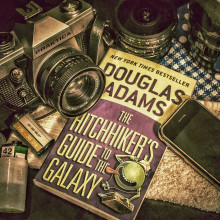
08:18 - Why is 42 "the answer to the universe"?
Why is 42 "the answer to the universe"?
Chris put this question to maths communicator James Grime from Numberphile...
James - 42 is a significant number because it was used by Douglas Adams as the answer to life, the universe, and everything, in a Hitchhiker’s Guide. Now, I can give you Douglas Adams’s answer first which is, it was a joke. And he had to pick a number and it had to be small to be funny. It had to be small. It had to be not significant. So you can't have a round number. That’s not funny and 42 will do. And I think it’s the sound as well. It has a sort of ‘ooh’ sounds, forty-two in English. So, it’s a funny number. It’s been used before as a funny number. Monty Python have used it. Lewis Carroll also used it in the same sort of way. I know someone who used to go through the phone book and find ways of making them phone numbers into 42.
Beverley - He or she? Were they a mathematician?
James - I don’t think they were. I don’t think they were. I think if you do something like that, the number 42 should really appear one out a hundred times. So, each – all things being equal, each two-digit number should be appearing, one in a hundred times. Though I have interesting things about 42. If you fold a piece of paper 42 times, it will reach from here to the moon.
Chris - I don’t think you could fold a piece of paper 42 times.
James - Yeah, I don’t think. So if you double it. Just imagine doubling a piece of paper. The width would reach from here to the moon. Someone who suggested that an efficient way of traveling around the world would be to take your two points on the globe, to drill a hole from one point to the other, have a nice frictionless tube going through the earth, and it would take 42 minutes just by force of gravity alone, just to drift from one point, and it will always take 42 minutes no matter where you're traveling to.
Chris - The only problem with that is of course that the pressure that the air would be under in that tube. Because obviously, as you descend further towards the centre of mass of earth, gravity means that you're making the gas more and more dense. The density of the gas in the middle of that tube, I think I'm right on that, aren’t I Jess, it would be something like running into a brick wall.
Jess - Yeah.
Chris - So, it wold probably take you a lot longer than your 42 minutes.
James - It’s clearly not 42.
Chris - Beverley?
Beverley - There's another answer. I've seen various calculations on how many kingdoms of life there are. It’s very hard to decide how many kingdoms. Everyone is taught five at school – plants animals, fungi, and so on. But most of the kingdoms of life out there are microbial. They all look the same to us. They differ in their chemistry. And so with the analysis of how many kingdoms there are in biology come up with 42, as an answer.
James - I am not surprised. I think it’s an example of a kind of confirmation bias. If you go looking for it, you will find it.
Chris - So, we blame Monty Python and Douglas Adams, but beyond that, it’s just because it sounds nice to say.
James - I would think so.
Chris - Did the Chinese people who speak quite differently, did they like the number as well or do they have their own magic ‘nice to say’ number?
James - So, I know that the science communicator, Alex Bellos has looked at world’s favourite numbers and there are cultural variations around the world. In the western world, you’ve asked for a favourite number, you'll get the number 7. But in China, you'll get the number 4, I believe.
Beverley - Is it about the number of syllables in the number? I've heard that Chinese people are much more mathematically-minded because there are far fewer syllables in their numbers especially – so going from 1 to 10, they can learn those much, much quicker than we can?
James - I can't speak to that. I know they have different systems of learning things though..

12:13 - How long would a fidget spinner spin for in space?
How long would a fidget spinner spin for in space?
Chris Smith put this question to Jess Wade from Imperial College London...
Jess - I think Sean has to think about all the forces that are slowing the fidget spinner down once you start spinning it. And have you done any experiments at home where you started off spinning and see how long it can spin for and time it? Have the kind of audience of the Naked Scientists or have you tried it?
Chris - Oh yes. The kids have been actually doing that and actually, they're having competitions to see who’s got the best bearings in their fidget spinner.
Jess - And what kind of time can they get to?
Chris - Something like a minute and a half, 2 minutes.
Jess - So I think that’s kind of important; what you said before about bearings. So it’s working because of angular momentum and angular momentum is conserved. We don’t get rid of angular momentum. It’s just transferred from one thing to the other. So once you…
Chris - Angular momentum being…
Jess - Kind of, how things were – oh gosh, I'm really going to push this answer, but okay, you can imagine it really nicely when you think about a ballerina or an ice skater spinning around and the person starts to spin around and puts out their arms out when they start spinning around and they spin around really, really slowly. And as they bring their arms in, they start to spin around much, much faster, and that’s because angular momentum is conserved and it’s actually, that the moment of (13:28) the thing stopping it spinning around is much, much smaller when you’ve got your arms inside. So, it’s kind of this motion in rotational direction.
Chris - So, instead of moving a big mass through a big circle, you move the same mass through a much smaller circle…
Jess - Exactly, right.
Chris - …so therefore, you have to go faster to keep everything balanced.
Jess - To keep everything balanced.
Chris - So that’s why your ice skater or ballerina speeds up. And the fidget spinner has got this property angular momentum and it can't get rid of it. It can't stop spinning.
Jess - It can't stop spinning and actually, the way that it stops spinning is because it transfers a tiny bit of that angular momentum to the earth. So as it’s spinning around, it makes the earth spin around the other way a tiny, tiny bit slower. And it starts to slow down over time. The other thing that you have happening when you're spinning your nice little fidget spinner in here is you have air resistance. So you have something pushing it back. You have something that is going up against, and you obviously have this friction of this ball bearing. So lots of things are going against your nice fidget spinner, making it slow down in about 2 minutes. If you take it up to the ISS and I'm sure they’ll take one up to the ISS the next time they go up.
Chris - International Space Station.
Jess - Yes, sorry. International Space Station, friends, biology friends, but you probably knew that. But if you took one up to the ISS, you're taking, you're reducing that force of gravity. So you’ve really only got the air resistance. So you’ve got air resistance going against you and it would probably still take – I mean, you could do it in probably years, I’d say, if you were reducing the air resistance. If you put it on the outside of the ISS, you're going to a much lower pressure that’s much less air resistance out there. I would say, kind of ‘timesing’ in – what's the pressure on the outside of the ISS? About 10 trillionth of the pressure in here, so probably…
Chris - It is probably 1 atom per cubic meter I think is the accepted density of space.
Jess - Not much. So, I would say it’s probably doing the maths. (15:10)we could ask a mathematician actually, but I would say tens of millions of years for it to slow down if it’s on the outside of the ISS.
Chris - It’s quite a long spin, isn’t it?
Jess - Yeah. So, there's an awful lot on earth that’s making that thing slow down and yet, even if you watch it, it still doesn’t seem to be slowing down very quickly. So, if you took that up to space, you'd have it for a lot longer.
Chris - I'm intrigued to think that by spinning my fidget spinner by making the earth spin the other way a little bit.
Jess - It’s great, right?
Chris - Because obviously, one has to think if enough people span their fidget spinner, would the earth slow down?
Jess - And I think you can also look. If you look on the Institute of Physics website, they have some great videos about that and also, the bottle flip. So, the bottle flip which was kind of the pre-fidget spinner nice demonstration of angular momentum and great kids trend is another thing that you can explore entirely through centre of mass and how different liquids that you put inside it, their viscosity and stuff like that. It’s a really fun experiment for kids today. You can film them in slow motion on your phone and you can watch the centre of mass stay entirely stationary as the bottle flips around. But that’s another great way that we can explore these things at home.
Chris - And if you actually want to have a look at how to do that experiment, there is a Kitchen Science experiment on our website explaining that one. You go to nakedscientists.com/kitchenscience.

17:07 - What is Elon Musk's hyperloop transport system?
What is Elon Musk's hyperloop transport system?
Chris Smith put this question to Angel investor and tech expert Peter Cowley...
Peter - Chris, I'm surprised you haven’t heard about it. You’ve heard about Tesla of course, some spaceX no doubt. Well, hyperloop is something that Elon Musk is working on. And this comes back to the 42 minutes to some extent because it’s a tube that is evacuated and then will transport people from one place to another. So, if you go back to when I was growing up in the ‘60s that we had – which is similar with places in retail, in department stores which would move the cash around. So you'd put something in a little container and it will get sent off from the cashier’s desk somewhere. The cash would then be changed and be come back down to the store. That’s exactly the same thing. So this is a long tube with a vacuum in it and then transporting down the tube are a set of people. Patterned by a guy in the ‘20s actually, Robert Goddard and Elon Musk has actually done this in interesting ways. It made it open source which means that anybody around the world can use these ideas and there's about 400 or 500 people working on this around the world. And the once that are closest to happening are the one between LA and San Francisco, one in Abu Dhabi, and one in South Korea. And basically, what they're doing, evacuating the tube down to about a millibar. That’s a 10,0000ths of an atmosphere and using either the sort of air hockey table approach or magnetic levitation to shift down a capsule with people in it.
Chris - And how fast will they go then?
Peter - It’s supposed to be going – well, they're certainly a but – they're still for some reason, which I don’t understand(18:35) which somebody else on the panel might do. There still seems to be a problem with sonic boom even though you’ve only got 1/10000 of atmosphere. So they're looking at about the 750 to 800 miles an hour. So nothing like as fast as it would be if you went round around the earth – sorry, through the earth. But it’s sort of the order of - San Francisco, Los Angeles is about 350 miles. We’re talking about half an hour for that trip.
Chris - Gosh! That would speed up the commute, wouldn’t it? That’s…
Peter - It’s true to commuters. It’s rather too fast, I think so.
Chris - I think so. But if you could shrink travel down on that sort of scale, it wouldn’t be, would it?
Peter - Exactly, yeah, yeah. Thinking there's something in the way like a piece of ocean or something like that. Of course, the issue is, the same as you get with early aviators is risk, isn’t it? People inside this capsule, what happens when something goes wrong? What happens when the power fails? What happens if there's a terrorist attack, etc.? And so, it will be the early adopters who will use it.
Chris - Will you head up on one of those Jess?
Jess - No. I mean, I think it’s super interesting. I was just thinking California and all of the bad traffic, all of the commuter’s nightmares are because of things like Google and Elon Musk, and Facebook. And all of those big things down in Palo Alto mean that the traffic in San Francisco and the idea of getting from San Francisco, not you drive obviously, you have to fly. But the traffic even to the airport is horrific, all because of these people working there. And yet, they're the ones developing the technology to shoot people in a tube.
Peter - That’s correct, but the biggest issue of all is they haven’t really adopted public transport, have they?
Jess - Yeah.
Peter - The rail system in the states is pretty poor, isn’t it?
Jess - Yeah.
Peter - So this is like putting a railway on and it’s terrible.
Jess - And like that they’ve just skipped the train line and just said, “Let’s package them in cat…”
Chris - What about things like earthquakes because that’s pretty important there too, isn’t it?
Jess - Oh yeah.
Chris - And you know, that could cause havoc if you have something hurdling along at 800 miles per hour and then suddenly, it depressurises because there's a rupture in the tube.
Peter - Correct or just even – yeah, a slightest variation is going to catch the sides and then who knows what then?
Chris - So would you say is it fair to say this is not something you'll be investing in soon, Peter? Are you out?
Peter - Yes, exactly.
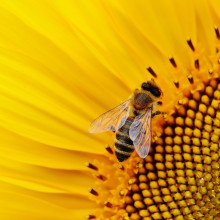
20:48 - Why are bees important to plants?
Why are bees important to plants?
Chris Smith put this question to Beverley Glover from Cambridge University...
Beverley - So back to my same point that actually, most of the things that define how plants function compared to other organisms is that they can't move. They're rooted to the spot. But just like any animal, they need to find a mate and they need to get the male gametes from one plant to the sperm from one plant to the female gamete, to the eggs of another plant. And the way they do that, they have to find somebody else to carry the stuff around for them. And the most successful and most commonly used and most popular thing for a plant to recruit to carry its pollen grains – they contain the sperm – around is a bee. And the reason for that is that bees are pretty smart. They can learn things. They can manipulate complicated structures. They're quite big. They can manage heavy flowers. They’ve got good colour vision. They can read cues and signals in the flower. And so actually, they're really, really good pollen vectors for plants. And an enormous number of plants rely on bees to get the male gametes from one plant to the female side of another. And without the bees, there wouldn’t be an awful lot of plant reproduction going on.
Chris - I did read a paper where scientists were showing that plants lace their nectar with caffeine and this seems to reinforce the memory of the bee for that particular flower strain, and may also give the bee a bit more energy. Now, is this true?
Beverley - It’s a very – it’s a cunning strategy. It’s a lovely paper. Yeah, so the flowers are rewarding the bees for doing this work with pollen and nectar. So pollen is full of nitrogen and nectar is full of sugar. And different bees are collecting one or the other at different times in the colony’s life cycle. And you can put different things into your nectar and pollen to make them more attractive, less attractive or to attract specific insects. So the basics in nectar or sugar and water, there are sometimes other micronutrients in there, the concentration of sugar might vary, the specific type of sugar might vary. And yes, some plants – it’s not that common and the citrus family are quite good at it, put caffeine into their nectar. And the experiments people have done have shown that bees form a search image of those flowers with caffeine in the nectar better and remember them better than they do flowers that don’t have caffeine in their nectar.
Chris - Jess…
Jess - Can I ask a physics related bumble bee question? So bumble bees feel magnetic fields, right? Do other insects feel magnetic fields?
Beverley - We don’t really know yet. There's some work on that and on how that works in perception but insects, it’s an enormous group and there's a lot of different, a lot of variation in there. A lot of them have different visual systems, different sensory systems, and different cognitive systems. So we don’t really know yet who can do what.
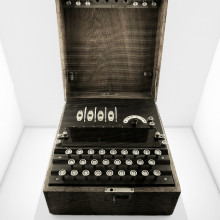
23:35 - How do the coding machines used in WWII work?
How do the coding machines used in WWII work?
Chris put this question to mathematician James Grime from Numberphile...
James - Yes. Well, there are more than one code machine in World War II. We’ll start with Enigma. So that’s the famous one. That’s the machine that was used by Nazi Germany in World War II to send their secret messages. So how did it work? Well mechanically, it’s just a circuit. It’s just a battery connected to a light. So you press a button, press a letter (A) for example, and the battery will connect to the letter (T), and it lights up. Now, what happens next is inside, there's a wheel and that wheel will turn. Now inside the wheel is full of wiring. So that’s where all the wiring is. So when that wheel turns, all the wiring gets turned which means the battery is connected to a different light. Which means if I press (A) again, it will become a different code letter. So, it’s constantly changing. That’s what made Enigma so difficult to decode.
Chris - So, how did you decode it then if you didn’t know where they started on the wheel?
James - So to decode, what you need to know is you need to know the correct starting position. So maybe miles away, you have your second German officer. They have an Enigma machine as well, set up exactly the same way as the first one. Then they type in the code, it will decode the message for them because mathematically, what the Enigma machine does is it turns 26 letters of the alphabet into 13 pairs. So, if I press (A) and it becomes (T), then (T) will become (A). So, it codes and decodes itself.
Chris - I see, right. When Alan Turing and his colleagues broke this code famously, how did they do it? What was the breakthrough?
James - So, well I think I should, just to be fair, we should mention that the Polish did this first. The Polish actually broke the code in 1932. So long before World War II, fantastically though, they managed to work out how the machine worked without ever seeing the machine, just from the codes alone. Love that! Just completely will be able to reverse engineer how the machine worked itself and then they could build their own replicas. The Polish did have methods to break those codes. Those methods were a little bit fragile and were likely to stop working. So this is what the British needed to do. They needed to come up with a method that could replace those Polish methods. Alan Turing had a method that used a flaw in the machine. I talked how the machine connects one letter to another in a pair. Well it makes 13 pairs, this means that a letter cannot be connected to itself. Now that was just a small clue. That’s not much. It’s a little clue, but it’s just enough to start breaking the code.
Chris - And so, how did they do it then? Because you still don’t know if you see a string of what appear to be random numbers or gibberish, how do you work out what was connected to what, the day that they wrote that message, where the rotor was effectively?
James - So, what you have to do is make a guess. So you guess a word or phrase that might be in that message. What the Germans would do in 6:00 o’clock in the morning, every morning, they would send a weather report. So, it was a standard letter. It was a standard form. You knew what that weather report said apart from the actual weather and you knew what that said. So you could use a phrase in that weather report and you will try and find it where it fits in the code. And we have a clue, a letter can't be itself. So if we use the word ‘weather’, or ‘Wetter’ in German, we know that a (W) can't become a (W), an (E) can't become an (E). So we can find where it fits. We can't have a matching letter. That’s not allowed. We find a match or when we find a position where it fits without a match, that bit of code might be the word ‘weather’. Now, we need to find the correct setting that makes that true.
Chris - So the weather is always our downfall, isn’t it? Thank you very much.
James - It’s very useful.
Chris - Jess, quickly.
Jess - Do you house an Enigma machine? Do you have one?
James - I do look after an Enigma machine.
Jess - Pretty cool!
James - That is cool. It is cool, isn’t it?
Chris - I think I've seen one. Simon Singh brought one to a talk we organised.
Jess - I think it’s that one.
Chris - It probably was, I think. So very impressive.
James - It may well have been the same machine that I look after.

27:44 - What happened to Google Glass?
What happened to Google Glass?
Chris Smith put this question to Angel investor Peter Cowley...
Peter - Google Glass was introduced in 2013 and sort of disappeared a couple of years later. It was a set of glasses that had a built-in android computer, a camera, and ear piece, and a microphone. The idea behind it was that you could effectively use it as – and it had a projection as well onto the glass so you could actually see a screen. So yeah, it was effectively a wearable computer. But there were a number of things wrong with it. The most important thing of all was the privacy issue and I remember being at a pitch event once when somebody was pitching to me. And this guy said, “Do you mind if we record the pitch?” There was about six of us in the room including somebody from Imperial College and we looked at each other and thought, “Ohh!” We can’t really say no because we’re technology investors, but we don’t really feel very good about it. And that I think was part of the problem that pushed back on it.
But Google have reintroduced it actually, only just recently in the last couple of months in an enterprise edition. So, what they’ve done is upgraded it. They’ve made it obviously better, technology moves on. They’ve also made it as a module which will fit onto safety glasses. It will fit onto spectacles, prescription spectacles, etc. And it’s been used in the industry for quite a long time in the last couple of years. It’s being used for picking. So you're picking stuff off shelves for instance. Being used for in training. There's a whole stack of applications for it which is very limited. So they’ve decided the general public don’t necessarily – aren’t ready for it which is probably true, which also got a red light that says it’s recording as well but that’s very minor! So effectively as a business tool, it’s out there still and that will grow, and there's no doubt. Whether it goes back or when it goes back into the public domain, I'm not sure.

Does water conduct electricity?
Chris Smith put this question to Jess Wade ...
Jess - This is a great question. A great nice chemistry question that you can do some experiments with at home. Basically, tap or well H2O as Thomas puts it doesn’t have any kind of ions in that could move the electricity around. So to move electricity, you need something that’s going to transport it. And you need something like the nice salt that’s in most tap water or the chlorine that’s in pool water, and these things, salt contains sodium and chlorine, and these things can catch the electricity and move it through the liquid, and take it to the other side. So, if you’ve got a battery, you could check that it’s working. You can also do another really neat experiment at home where you got those sports drinks. So, sports drinks make kind of big claims about the electrolytes that they have inside them and you can actually test that by setting up a kind of little circuit and seeing whether you could conduct through a sports drink because those things should also be able to conduct electricity. So, if you have a swimming pool, you can do it because you can use the chlorine ions. If you’ve got normal water, you can do it because it’s probably got salt in. And you can get rid of most of the minerals I think within water can't conduct. So, that’s your limiting factor there. You have lots of stuff inside normal water that you get out, but they're not conductive so you need something it can conduct.
Chris - So, would pure water, pure, clean, distilled water still conduct electricity or not?
Jess - No.
Chris - Not at all.
Jess - If it didn’t have any salt in it, it shouldn’t conduct electricity at all.
Chris - It’s a little bit ionised, so isn’t it you get a tiny bit of breaking of the – the H2O goes into a bit of H plus and a bit of OH minus so you can get a tiny, tiny…
Jess - Okay. Probably a teeny, teeny, tiny bit. But probably, nothing that we could detect.
Chris - Nothing that would be meaningful.
Jess - Nothing that would be meaningful for Thomas.

32:02 - What was the first animal to orbit Earth? Quizzing the Experts!
What was the first animal to orbit Earth? Quizzing the Experts!
with Beverley Glover, University of Cambridge; Peter Cowley, Angel Investor; James Grime, Numberphile; Jess Wade, Imperial College London
Plant scientist Beverley Glover from Cambridge University, tech expert and Angel investor Peter Cowley, Imperial College London physicist Jess Wade and mathematician James Grime from Numberphile are all put to the test by Chris Smith...
Chris - Question one, this is for Beverley and James. The light bulb was invented by Thomas Edison. Is that a science fact or is that a science fiction, do you think?
James - I believe I could answer this one, yeah. That sounds like nonsense to me.
Beverley - Oh dear!
James - I'm thinking it might have been one of the early people who profited from electricity and the light bulb, but I do not think it is correct to say that he invented the light bulb.
[Bing!]
Chris - Yup! You're on the money. It’s now generally accepted that British physicist Joseph Swan was the inventor of the modern light bulb. Edison developed a commercially viable and practical electric light bulb for the mass markets. So, well done to you two. Okay, over to Jess and Peter. Radiation was discovered by Marie Curie. Science fact or science fiction, do you think?
Peter - I suspect, not. I think, it’s probably the same that she was named for it, but not – was the one. Do you know, Jess?
Jess - I have never worked with – I mean, she has the big name, right? so, I'm assuming in the same way to the other one. She probably was the first one to measure it maybe, but…
Peter - Sorry, yeah. I was looking for…
Jess - I want to come up with a great answer about who actually did discover it, but maybe they died too quickly.
Chris - Are we going fact or fiction?
Jess - We’re going fiction.
Peter - Fiction, yeah.
[Bing!]
Chris - Well, my mouse button wouldn’t work. You're both on 1 point each. This has been quite tense this week. Normally, by this time, we’ve already got a lead. Sorry, James.
James - Discovery of radiation, was that?
Chris - I will answer. I’ll tell you. So, Marie Curie is often credited with the discovery of radiation but she actually coined the term ‘radioactivity’ but it was actually her doctoral supervisor who was Henri Becquerel who first discovered its existence. He was the one who famously showed that uranium salts, if you put them on a hard piece of paper or card that you had wrapped around a photographic plate could fog the photographic plate. So there was some invisible ray that was going through the card and hitting the photo plate.
James - Isn’t light radiation?
Chris - Yes, it is and Rontgen had invented x-rays before that and used his wife’s hand to produce some of the first x-rays. But actually, radiation, in terms of radioactivity that we’re talking about here was invented, not by Curie but by Becquerel.
Jess - We measure it in Becquerel, right? So, he does get some credit.
Chris - So, he gets his credit. He gets his name on the unit, that’s right. now, we’re on to round 2 which is firsts. We’re calling this round ‘firsts’. Now, what Beverley and James, was the first animal to orbit the earth?
James - That sounds like fun.
Beverley - It was a dog, wasn’t it?
James - Yeah.
Beverley - A Russian dog.
James - Dog sounds like a good answer. You think I think of chimpanzees.
Beverley - I think it was a dog.
James - But I think it might be rats or mice. I think it might be something simpler. Do you want to go for dog or rats or mice?
Beverley - I want to go dog.
James - Okay, we’ll go dog.
[Bing!]
Chris - The Soviet Union led the way on this one. They were the first to send an animal into orbit and Laika who was formerly a stray dog on the streets of Moscow, she was the first animal officially to orbit the earth when she successfully blasted into space aboard Sputnik 2 in November 1957. We do have to acknowledge though that she didn’t come back and there was no way to retrieve her from space with the technology they had at that time. So unfortunately, she went up. She was a pioneer, but she also died up there. Now question four – this is for you guys, what came first, Jess and Peter, a genetically modified plant or a genetically modified animal?
Peter - I don’t know.
Jess - I think it was a plant.
Peter - Yes, so it would be more likely to be a plant, isn’t it?
Jess - It’s easier, maybe. Oh, sorry. Don’t want to get in there with that. I have a feeling that an animal came much later. Okay, I'm going to say something stupid about Dolly the sheep that wasn’t the first time they genetically modified an animal. Let’s go with plant.
Peter - Yup!
[Bong!]
Chris - Did you know that one Beverley?
Beverley - I think I did.
Chris - Yeah. Actually, the answer is that in 1974, Rudolf Jaenisch made the first genetically modified mouse. We’ve heard of Jaenisch on this program. He’s actually one of the scientists who invented or co-invented the IPS, the Induced Pluripotent Stem Cell, where they reprogram an adult cell to become a stem cell. But he produced the first genetically modified mouse in 1974. It was until 1983 that the first GM plant which was actually a strain of tobacco got produced by Michael Bevan, Richard Flavell, and Mary-Dell Chilton. Now why do people assume plants are easier than animals because it would appear from this discovery that they're not, Beverley?
Beverley - I think it’s about whether where the effort had gone in actually. So plants probably are easier because the trick about any kind of genetic modification is you modify a single cell and then you want to generate a whole organism back from that. And as we know with animals, that means either taking a stem cell and modifying that or taking a cell that’s already committed to on a fate and de-differentiating it back to a stage where it can create anything. That’s really tricky. That’s why there's so much research on stem cells whereas with plants, actually all cells are pluripotent and you can persuade pretty much any cell in a plant to regenerate a whole new plant if you give it the right hormones and the right sugars.
Chris - So, why did it take so long to do a plant compared to a mouse?
Beverley - There's an awful lot less plant scientists out there than there are animal scientists.
Chris - That will be the reason then. Right, okay. Beverley and James, in one second, we want to know what’s larger. So this is all about size or scale. In one second, what's larger, the number of dead skin cells that drop off your body or the number of laps of a 27-kilometer long Large Hadron Collider circuit that’s made by a packet of protons? So, what's more, dead skin cells falling off your body every second or the number of laps done by a packet of protons in the 27-kilometer long loop of the Large Hadron Collider?
James - What do you think? Do you think…
Beverley - I think skin cells.
James - You think skin cells. It sounds like you want to say Hadron Collider and so, I'm going to say – yeah, you think that they're trying to trick us?
Beverley - Okay.
James - I’d say skin cells, yeah.
[Bong!]
James - Too clever!
Chris - No. The answer is the proton laps actually. Scientists estimate, the average person sheds about 500 million skin cells in a day. So that’s about 6,000 dead skin cells dropping off you every second. But traveling at just 3 meters per second slower than the speed of light, CERN reckon that the protons accelerated in their LHC complete over 11,000 laps of the 27-kilometer long ring every second. So the protons currently clinch it. Right, it is ought to play for, okay. So, it’s level pegging so you’ve got to save your reputation here, Jess and Peter. Okay, here we go. The weight of all humans on earth or the weight of all ants on earth. Which is bigger, the humans or the ants, do you think?
Peter - I would guess, ants. The number of ants on this globe must be astronomical.
Jess - Yeah.
Peter - Astronomically more, must be.
Jess - I'm with you on that. They're underneath as well. They win.
Peter - Yeah.
[Bong!]
Chris - No, I'm sorry. Actually, it’s the humans, okay.
Jess - How different is it?
Chris - Ants weigh…
Jess - What if we take out China?
Chris - Ants weigh about 5 milligrams and we think, although we don’t know but scientists think there are 10,000 trillion ants on earth. So a likely estimate for their combined mass would be about 40 billion kilos or so. There are over 7 billion humans though and their combined weight is more than 300 billion kilos if you take everyone over the age of about 15. So, we outweigh the ants by almost an order of magnitude. But historically, if we’ve been doing this quiz in the 18th century, you probably would’ve been right because scientists also extrapolated backwards and suggests that around the time of the industrial revolution, so the 1700s, ants did probably outweigh us because there were fewer people around.
Peter - Can I challenge the 5 milligrams per ant?
Chris - You can certainly challenge. I'm not going to give you a point.
Peter - It seems remarkably low.
Chris - Well, no. Ants range between about 1 milligram and about 50 milligrams for some really big ones.
Peter - Is that right?
Chris - So actually, yes. And if you look at the… Beverley, do you know about ants?
Beverley - Yeah and you even get variation on that kind of order of magnitude within a single ant species. So, within a colony, you’ve got worker ants, soldier ants, and different types of ants, and you can have enormous variations in size. Scientists actually use them to try and understand how body mass and things like claw sharpness scale with size because they're such variable group.
Chris - Now, isn’t that wonderful? We’ve ended with both teams scoring the same. So your level pegging and you depart with your reputation intact.

41:22 - What's the biggest prime number that we know of?
What's the biggest prime number that we know of?
Chris Smith put this question to maths communicator James Grime...
James - So, a prime number, you may remember from school are those numbers that can only be divided by one and itself. You're right. you will hear in the news announcements about the newest largest prime number we found. The reason that’s important is we do use large prime numbers in encryption and in internet encryption. But also, it’s an exercise in our computers, in computational power. And so, that’s why we have holes. We haven’t been working out the primes one at a time which we can do with ancient methods, by sieving through the numbers, but what we have instead are probabilistic methods to work out extremely high prime numbers. No, we haven’t been working through them one at a time. Where does it stop? Where is that first gap? It must be huge. I do not know that number off the top of my head, but it must be absolute massive.
Chris - Riemann who was a famous mathematician had a prize of I think it’s a million dollars that’s been put up for someone who can come up with a formula for predicting prime numbers but it’s never been claimed.
James - That’s right. that’s the Riemann hypothesis. This must be around 1850. He came up with this function that could be used to work out not where the prime numbers are but where we’re counting the prime numbers. So, we want to know how many prime numbers are less than 100. So, I don’t know what that is. I think it’s about 22 or there must have been. You might want to know how many prime numbers less than a billion. So, we need to know that proportion. Riemann had a method for working out what the error might be in that formula and that will help us predict the pattern in the primes.
Chris - Let’s hope so and then you can make yourself a million, couldn’t you, if you could…
James - And then you can claim…
Chris - You can claim the prize.
James - …this million-dollar prize, absolutely.

43:38 - Can electromagnetic waves be used to search for deep underground water?
Can electromagnetic waves be used to search for deep underground water?
Chris Smith put this question to Jess Wade from Imperial College London...
Jess - I think that they do detect deep underground water using this. I think first, you can do it with electricity in a similar way to what we were talking about before about water being non-conductive. You can basically put electricity into rocks and set up two little electrodes and find out water base on how non-conductive your rocks are, so you can make estimates about how conductive different rocks are because of the ions that are inside them.
Chris - But does that tell you that there's a big pool of water at position (X) underground?
Jess - So you can because you can make an educated guess about how conductive a surface should be based on the rocks that there are inside it. And then you can tell how non-conductive it is because of this big body of something that’s basically an insulator. But you can also do much more clever ways, kind of a bit similar to MRI so you can excite the kind of hydrogen nuclei inside water and look at the signals that they give off. And you can use that to estimate again, how much water is under there. And then you can even do more clever things. When you’ve got this water, you can find out how old it is by doing things like carbon dating so you can figure out how old this pool of water is and the kind of flow and stuff like by looking at that.
Chris - And a V-shaped birch log, is that good?
Jess - Yeah, you can do that if you’ve got a nice tree, I think if you're going into that way. But I'm pretty sure you can detect waves underground. You can detect electromagnetic waves underground and that’s actually probably how an awful lot of earthquake detection and stuff like that happens.
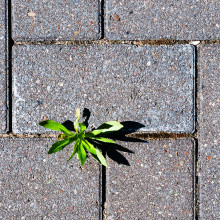
Why are weeds so persistent?
Chris Smith put this question to Beverley Glover from Cambridge University...
Beverley - Well, that’s because that’s what their job is. There are basically a group of scientists set out a theory for ways to be a plant, different ways to approach life as a plant by 30 or 40 years ago now. And they said, you know, you can be a kind of, ‘stay still and grow slowly and hang on to all your resources plant something fairly grumpy like a cactus. You can be a ‘grow fast and strong and beat all the competition but not reproduce very quickly plant’ so you might think of something like a bramble or you can be a ‘live fast and die young plant’. So, live fast, die young but throw out a lot of seed while you're doing it. And that’s basically the strategy weeds take. So, you can dig out one of them but it’s only lived a few weeks. Then that’s few weeks, it might have thrown out a million seeds and they’ll come up as soon as you pull up the first one.
Chris - And bind weed because that has a different strategy, isn’t it? That has roots that are extremely fragile but it can clone the plant back from any tiny bit of them.
Beverley - So, it’s more in the bramble category. It’s actually a competitor. It’ll keep going endlessly.
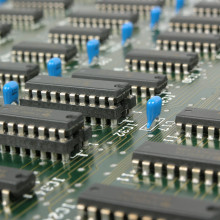
46:20 - What's the smallest microchip we can make?
What's the smallest microchip we can make?
Chris Smith put this question to tech expert Peter Cowley...
Peter - Yeah, that is an interesting question. I'm not quite sure he means microchip. Let’s just do a bit of a background. So first of all, the track width of a transistor nowadays has got down to about 7 nanometres.
Chris - Transistors are the things inside chips that make the computer tick effectively, aren’t they?
Peter - Exactly, yes. Okay. So that’s not actually in production yet. They're down to about 10 nanometres. That’s about 10,000th of a human hair. Its visible light is 40 times big, wider than that with the wavelength of that. But I'm sure that’s not the question because that transistor is just on or off. What we’re probably talking about is microprocessors and I brought in something that’s about the same…
Chris - This is the gadget, isn’t it, that you said to me you'd – you brought this is in. We said at the beginning, Peter has brought a gadget in and he’s going to tell us what it is. This is a big box. It’s probably at 20 centimetres by 15 centimetres and about 5 deep with lots of wires and circuit boards. What is that?
Peter - So, this is the first computer that I developed and built as you can see, very badly built built back in 1975. The reason I brought it in is because it had a processor that had about 4,000 transistors in it called a scamp in fact. This has 32 bytes of memory.
Chris - Gosh! That’s a lot, isn’t it?
Peter - You know, you can't do much with 32 bytes of memory, can you? But I just want to compare that with modern microprocessors or microchips.
Chris - Why did you build that? What did it do?
Peter - I built it because I want to learn how to build a computer. (inaudible) necessarily want going through with it. You have to enter the – on the front side, there are some switches and you have to enter the program on these switches. There are 16 bytes of RAM so you have maximum of 16 instructions and it will switch some LEDs on, Light Emitting Diodes on, on the front. Anyway, that was just an example of that. But nowadays, we’ve got processors that have got billions of transistors in rather than a few thousand. That’s about 600, 700, 800 square millimetres and it got GPUs which are even more. But I think actually…
Chris - That’s Graphic Processing Units.
Peter - Graphic Processing Unit. The question has possibly to do with, how are we going to do in the future? Quantum computing where you’ve got multiple of these quantum bits or these are investment I nearly made down in Cambridge which was storing data of strands of DNA. Then you’ve something, then you’ve got petabyte, you’ve got huge amounts of volume of data, possibly as much as there's on the earth in the size of a bucket really.
Chris - Yeah. The DNA thing at the moment is being held back by the fact that it’s extremely expensive to make and then decode DNA and not…
Peter - Well, to write it is not – well, to read is not too bad because there have been sequences around for years. To write it is…
Chris - Yeah and to make the DNA is very expensive.
Peter - Exactly.
Chris - But people are saying it’s a bit like the sort of Rosetta stone. It’s a very long lived, very stable molecule that you could put your information in and you know it will be (crosstalk)
Peter - It will last hundreds of millions of years, exactly for long term storage.

49:00 - What's the best way to water potted plants?
What's the best way to water potted plants?
Chris Smith put this question to Beverley Glover from Cambridge University...
Beverley - Well, you might be. One of the biggest insults one of my gardeners at the Botanic Garden can say of another of this colleagues was that there are classic overwaterer and a classic overwaterer always waters from the top down. But actually, it doesn’t really matter which way you do it as long you don’t leave them sitting in it. So the problem with water from a plant’s point of view is that their roots need to be able to respire just like the above ground tissues, they need to be able to take in oxygen and give out carbon dioxide and they can't do that if their water logged. So as long as whichever you do, you give it a few minutes and then you drain away the excess, it will probably turn out alright.
Chris - Because someone said to me, you mustn’t water your African violet from the top because it will go rotten, and mouldy, and manky. I must admit, I did water an African violet like that. It was my wife’s and I killed. And I felt terribly, terribly guilty. Am I off the hook?
Beverley - I think you are off the hook. You would’ve killed it either way. [laughs]
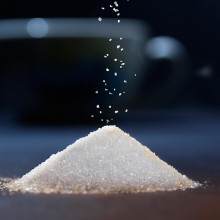
50:10 - How many grains are in a teaspoon of sugar?
How many grains are in a teaspoon of sugar?
The team guess how many grains in a teaspoon of sugar...
Beverley - I can think of how to do it. I can't think what the number would end up like.
James - Just talk us through what you would think.
Beverley - Well, I need to know the volume of my grain of sugar. Was it granulated or castor? I think we agreed castor. I need to know the volume of my teaspoon and then that’s a fairly simple sum. The volume of teaspoon is presumably quite hard. Oh no, we know what it is. It’s 5 ml. It would be quite hard to calculate.
James - I think your method is excellent.
Chris - You have to give us a number. You can't get out of it so what's your number?
Beverley - 50 million.
Chris - Okay, 50 million from Beverley. Jess?
Jess - I weigh lots of small stuff in the lab. I work in printed electronics with these tiny, tiny little amounts of polymers or small molecule. I would say that a grain of sugar weighs about half a milligram?
James - Yeah. It’s about – I've got here 0.2 milligrams.
Jess - Okay, so I'm going to go with like 25,000.
Chris - So how many do you have? 25,000 particles. And Peter?
Peter - I'm going to use a special number, 3 to the power of 6.
James - 3 to the power of 6.
Peter - 729. Now I know it’s too low but I suspect…
Chris - Not 42?
Peter - No, I couldn’t get it that low.
Chris - So James, you better tell us then to put us out of our misery then. Who’s closest?
James - Well, I think a very excellent answer was Jess with her 25,000. I have an answer here of 20,000 based on 4 grams of sugar weighing about 0.2 milligrams.
Chris - Okay, so can you show us your working because that’s very important in maths to show your working, isn’t it? So how did you do that and you have to do it in 30 seconds.
James - So, like Beverley’s method, we can look at how big the crystals are. The diameter of a crystal might be about 0.7 millimetres. We have to look at how efficiently they're packed in as well, because there is space in-between them. So we’re thinking about 60 per cent packed in and, going through the calculations, we will get the answer 20,000.










Comments
Add a comment